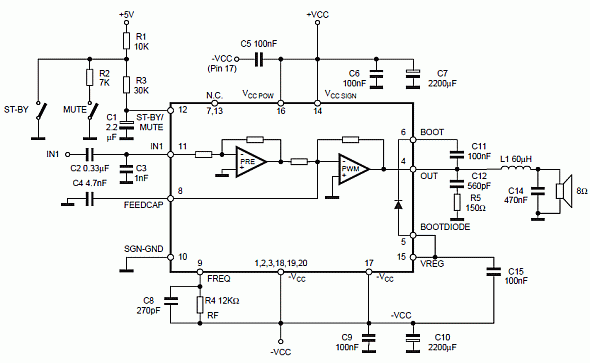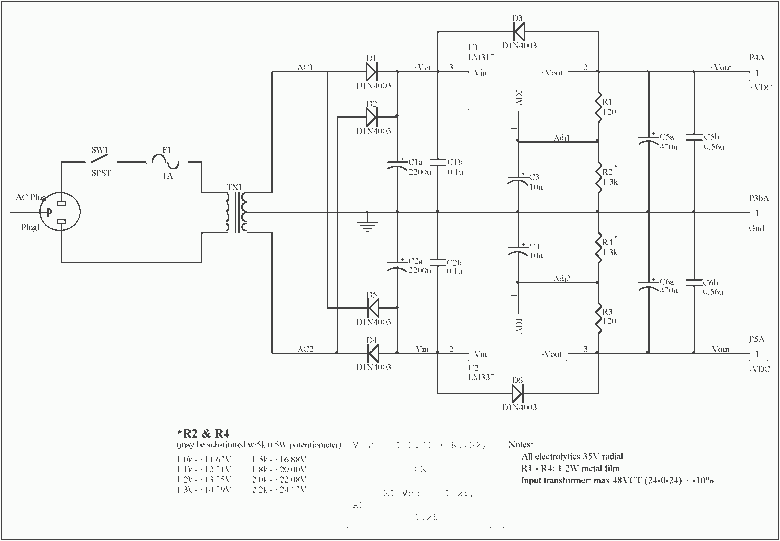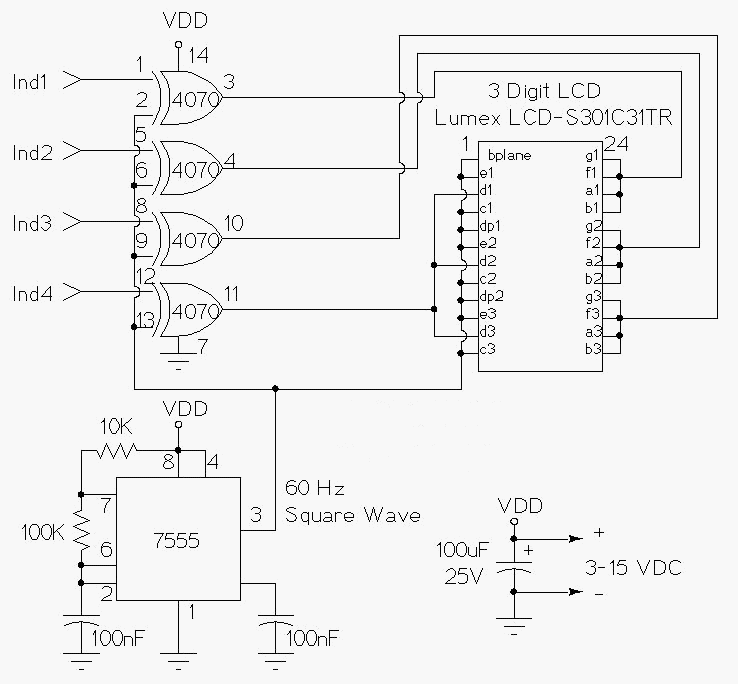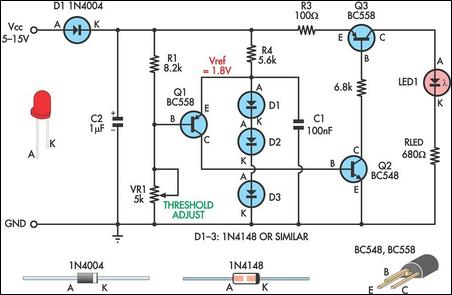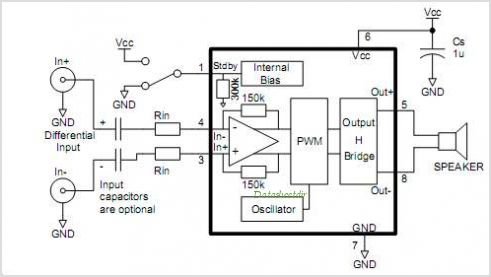
switching power supply 4
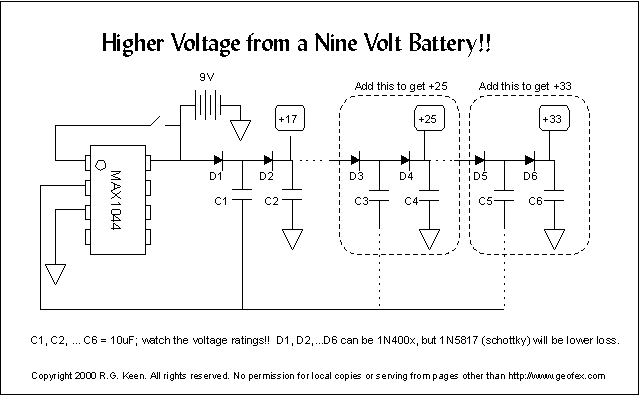
The MAX1846 inverting circuit implements a switch-mode power supply that provides -15V at 0.5A output from a 4.5V to 12V input. This circuit incorporates additional components beyond the minimum implementation. C20 introduces a pole to compensate for the ESR-zero of the output capacitor, while R16 and C22 filter the current-sense voltage to prevent high-frequency switching noise from triggering the current limit. This feature complements the MAX1846's internal 100ns current-sense blanking time. The EXT pin of the MAX1846 facilitates controlled slew rate, thereby minimizing high-frequency switching noise. The MAX668 boost circuit also implements a switch-mode power supply that provides +15V at 0.5A output from a 4.5V to 12V input. Similar to the MAX1846, this circuit includes additional components; C7 compensates for the ESR-zero of the output capacitor, and R5 and C8 filter the current-sense voltage to avoid high-frequency switching noise from prematurely activating the current limit, in addition to the MAX668's internal 60ns current-sense blanking time. The output voltage of the MAX668 can be adjusted to +12V by changing the R2 resistor value to 86.6k, which reduces the minimum input voltage to approximately 10V. Since the MAX668 has internal compensation, no further modifications are necessary for a +12V output. The output ripple voltage due to switching can be significantly reduced with a secondary output filter set to one-tenth of the switching frequency. A 1.0W resistor in series with a 10µF, 25V capacitor with less than 100mΩ ESR results in a 0.5V decrease in output voltage at a 0.5A load. The feedback voltage must be sensed prior to reaching the secondary filter for the MAX668 to maintain stability. A power supply source of approximately 12V from a 4A battery can be enhanced to 24V using this circuit, which has notable advantages. It utilizes the digital integrated circuit CD4093 to produce frequency drive current changes, while the CD40106 bilateral group facilitates operation. By driving high current with the power MOSFET BUZ11, the output current can be collected at capacitors, effectively doubling the input power supply voltage. The circuit can generate approximately 70V using a current of around 4mA at a 6V input voltage. An easily available stroboscope trigger coil allows for a compact design. The integrated circuit 7555 generates a 50/50 square wave at approximately 100 kHz. The rising edges of the square wave momentarily trigger the transistor into conduction, allowing current to flow through the primary of the stroboscope transformer. The current pulse in the primary induces a much larger voltage pulse in the secondary of the transformer, charging the output capacitor through diodes. The 7555 (CMOS variant of the NE555) is preferred for generating the square wave due to its superior performance with power supply transients compared to the NE555. The circuit topology enables the generation of a 50% duty cycle square wave with minimal external components (the resistors connecting output to threshold/trigger and the capacitor between threshold/trigger and ground). The choice of transistor is flexible; a BC550 was used due to availability. On the rising edge of the square wave, the transistor is activated through the capacitor, quickly switching off as the capacitor discharges through the resistor connecting the base to ground. A diode is placed across the transistor's emitter and collector to protect against negative voltage spikes from the primary winding. The stroboscope trigger coil is rated for 4 kV, designed to convert a 300V pulse into 4 kV in its original application, indicating a significant step-up ratio.
The MAX1846 and MAX668 circuits are designed to efficiently convert input voltages to desired output levels while maintaining stability and minimizing noise. The integration of filtering components, such as capacitors and resistors, is crucial for ensuring that high-frequency noise does not interfere with current sensing and regulation. The use of controlled slew rates and internal compensation mechanisms demonstrates advanced engineering techniques aimed at enhancing the performance of switch-mode power supplies. Furthermore, the incorporation of additional circuitry, such as the CD4093 and CD40106, showcases the versatility of these designs, allowing for voltage multiplication and high-voltage generation in compact configurations. The choice of components, including the 7555 timer and the stroboscope transformer, highlights the importance of selecting suitable elements for specific applications, ensuring reliability and efficiency while achieving the desired electrical characteristics.The MAX1846 inverting circuit to implement a switch-mode power supply that provides a -15V at 0. 5A output from a 4. 5V to 12V input. This MAX1846 circuit also adds a few components to the minimum circuit implementation. C20 adds a pole to compensate for the ESR-zero of the output capacitor, while R16 and C22 filter the current-sense voltage to prev ent high-frequency switching noise from tripping the current limit. This functionality is in addition to the MAX1846 ²s internal 100ns current-sense blanking time. The MAX1846 EXT pin implements controlled slew rate, which helps limit high-frequency switching noise. The MAX668 boost circuit to implement a switch-mode power supply that provides a +15V at 0. 5A output from a 4. 5V to 12V input. This MAX668 circuit adds a few components to the minimum circuit implementation. C7 adds a pole to compensate for the ESR-zero of the output capacitor. R5 and C8 filter the current-sense voltage to prevent high-frequency switching noise from prematurely tripping the current limit.
This functionality is in addition to the MAX668 ²s internal 60ns current-sense blanking time. The MAX668 output voltage can be changed to +12V by changing the value of the R2 resistor to 86. 6k This change reduces the minimum input voltage to approximately 10V. Since the MAX668 provides internal compensation, no other changes are required for +12V output. The output ripple voltage due to switching can be reduced an order of magnitude with a secondary output filter set to one-tenth of the switching frequency. A 1, 0. 5W resistor in series with a 10uF, 25V capacitor with less than 100m ESR introduces a 0. 5V decrease in output voltage at a 0. 5A load. The feedback voltage must be sensed before it reaches the secondary filter for the MAX668 to maintain stability.
If you have power supply source about 12V, from battery 4A sizes. But want to enhance voltage be 24V or about 2 times. This circuit has can to help you by it has prominent easy good point. It use the integrated circuit digital number CD4093 perform produce the frequency drive current change CD40106 bilateral the group trips work. By drive high current with power mosfet BUZ11 make output current collect at capacitors the very total up voltage bilateral the group then is double of Input power supply.
or It can enhance voltage double, be 2 times there. The circuit can be used to generate a voltage of about 70V using a current of about 4 mA @ 6V input voltage. The use of an easily available stroboscope trigger coil makes it quite small. The integrated circuit is a 7555 generating a 50/50 square wave of around 100 kHz. The square wave`s rising edges momentarily trigger the transistor into conduction, causing current to flow through the primary of the stroboscope transformer.
The current pulse in the primary causes a much larger voltage pulse in the secondary of the transformer, thereby charging the output capacitor through the diodes. I`m using the 7555 (CMOS variety of the NE555) to generate the square wave, because it behaves much better with respect to power supply transients than the NE555.
The circuit topology used here makes it possible to generate a 50% duty cycle square wave with only few external components (the resistors from output to treshold/trigger and the capacitor between treshold/trigger and ground). The type of transistor is not very important I think. I just used a BC550 because I had it available. On the rising edge of the square wave, the transistor is switched on through the capacitor. It is quickly switched off, because the capacitor discharges through the resistor between base and ground.
I connected a diode across the transistor`s emitter and collector, to protect it against the negative voltage spike from the primary winding. The stroboscope trigger coil is a 4 kV type, meaning that it is supposed to convert a 300V pulse to 4 kV in its original application (a step-up ratio of ab
🔗 External reference
The MAX1846 and MAX668 circuits are designed to efficiently convert input voltages to desired output levels while maintaining stability and minimizing noise. The integration of filtering components, such as capacitors and resistors, is crucial for ensuring that high-frequency noise does not interfere with current sensing and regulation. The use of controlled slew rates and internal compensation mechanisms demonstrates advanced engineering techniques aimed at enhancing the performance of switch-mode power supplies. Furthermore, the incorporation of additional circuitry, such as the CD4093 and CD40106, showcases the versatility of these designs, allowing for voltage multiplication and high-voltage generation in compact configurations. The choice of components, including the 7555 timer and the stroboscope transformer, highlights the importance of selecting suitable elements for specific applications, ensuring reliability and efficiency while achieving the desired electrical characteristics.The MAX1846 inverting circuit to implement a switch-mode power supply that provides a -15V at 0. 5A output from a 4. 5V to 12V input. This MAX1846 circuit also adds a few components to the minimum circuit implementation. C20 adds a pole to compensate for the ESR-zero of the output capacitor, while R16 and C22 filter the current-sense voltage to prev ent high-frequency switching noise from tripping the current limit. This functionality is in addition to the MAX1846 ²s internal 100ns current-sense blanking time. The MAX1846 EXT pin implements controlled slew rate, which helps limit high-frequency switching noise. The MAX668 boost circuit to implement a switch-mode power supply that provides a +15V at 0. 5A output from a 4. 5V to 12V input. This MAX668 circuit adds a few components to the minimum circuit implementation. C7 adds a pole to compensate for the ESR-zero of the output capacitor. R5 and C8 filter the current-sense voltage to prevent high-frequency switching noise from prematurely tripping the current limit.
This functionality is in addition to the MAX668 ²s internal 60ns current-sense blanking time. The MAX668 output voltage can be changed to +12V by changing the value of the R2 resistor to 86. 6k This change reduces the minimum input voltage to approximately 10V. Since the MAX668 provides internal compensation, no other changes are required for +12V output. The output ripple voltage due to switching can be reduced an order of magnitude with a secondary output filter set to one-tenth of the switching frequency. A 1, 0. 5W resistor in series with a 10uF, 25V capacitor with less than 100m ESR introduces a 0. 5V decrease in output voltage at a 0. 5A load. The feedback voltage must be sensed before it reaches the secondary filter for the MAX668 to maintain stability.
If you have power supply source about 12V, from battery 4A sizes. But want to enhance voltage be 24V or about 2 times. This circuit has can to help you by it has prominent easy good point. It use the integrated circuit digital number CD4093 perform produce the frequency drive current change CD40106 bilateral the group trips work. By drive high current with power mosfet BUZ11 make output current collect at capacitors the very total up voltage bilateral the group then is double of Input power supply.
or It can enhance voltage double, be 2 times there. The circuit can be used to generate a voltage of about 70V using a current of about 4 mA @ 6V input voltage. The use of an easily available stroboscope trigger coil makes it quite small. The integrated circuit is a 7555 generating a 50/50 square wave of around 100 kHz. The square wave`s rising edges momentarily trigger the transistor into conduction, causing current to flow through the primary of the stroboscope transformer.
The current pulse in the primary causes a much larger voltage pulse in the secondary of the transformer, thereby charging the output capacitor through the diodes. I`m using the 7555 (CMOS variety of the NE555) to generate the square wave, because it behaves much better with respect to power supply transients than the NE555.
The circuit topology used here makes it possible to generate a 50% duty cycle square wave with only few external components (the resistors from output to treshold/trigger and the capacitor between treshold/trigger and ground). The type of transistor is not very important I think. I just used a BC550 because I had it available. On the rising edge of the square wave, the transistor is switched on through the capacitor. It is quickly switched off, because the capacitor discharges through the resistor between base and ground.
I connected a diode across the transistor`s emitter and collector, to protect it against the negative voltage spike from the primary winding. The stroboscope trigger coil is a 4 kV type, meaning that it is supposed to convert a 300V pulse to 4 kV in its original application (a step-up ratio of ab
🔗 External reference
Warning: include(partials/cookie-banner.php): Failed to open stream: Permission denied in /var/www/html/nextgr/view-circuit.php on line 713
Warning: include(): Failed opening 'partials/cookie-banner.php' for inclusion (include_path='.:/usr/share/php') in /var/www/html/nextgr/view-circuit.php on line 713
